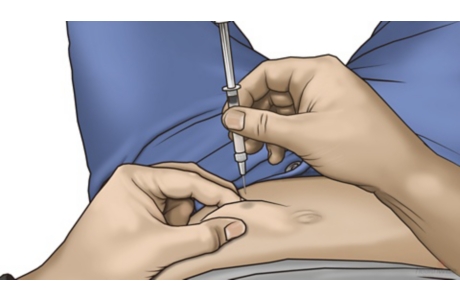Common Questions About Giving Yourself Shots
Overview
How do I get rid of an air bubble in the syringe?
Here is what to do if you notice an air bubble in the syringe.
- Hold the syringe so the needle points up.
- Tap the barrel a few times to move the air bubble to the top.
- Slide the plunger enough to push the air out before you give the shot.
- Make sure you have a full dose in the syringe.
You may need to add a small amount of medicine to the syringe to get a full dose.
Injecting a small air bubble into the skin or a muscle is usually harmless. But it might mean you aren't getting the full dose of medicine, because the air takes up space in the syringe.
What if I break or bend a needle?
Here is what to do if you bend or break a needle while giving yourself a shot.
- Carefully remove the needle if you can.
Dispose of the needle in a safe way (in a hard plastic, metal, or "sharps" container with a lid).
- If no medicine went in, you can give yourself another shot.
If some medicine went in, check with your doctor before you give yourself another shot.
- If you're bleeding after you remove the needle, apply direct pressure to stop the bleeding.
Clean the wound with soap and water, and cover it with a bandage, if needed, to protect it.
If you can't remove the needle, or if a broken part of the needle didn't come out, you need medical attention. A doctor will help remove the needle.
What if I see blood in the syringe?
If you see blood in the syringe, it means you might have hit a blood vessel. This usually isn't harmful. If you see blood in the bottom of the syringe (hub) before you push in the plunger:
- Remove the needle without giving the medicine.
- Dispose of the needle in a safe way.
Use a hard plastic, metal, or "sharps" container with a lid.
- Use a new needle to give the shot.
You can put a new needle on the syringe and then give the injection in a new spot.
What about infections?
To help prevent infection when giving yourself a shot, always wash your hands, clean the injection site, and keep your needles sterile.
If you notice signs of infection, call your doctor. These signs include:
- Increased pain, swelling, warmth, or redness around the injection site.
- Red streaks leading from the site.
- Pus draining from the site.
- A fever.
How do I rotate injection sites?
Your doctor or nurse will show you where you can inject your medicine. Keep track of where on your body you inject your medicine. You may want to note the site and the date on a diagram of your body. Give your next shot in another area, or at least an inch away from your last shot.
Is bruising okay?
Bruising means you might have hit a small blood vessel. This usually isn't harmful. If you have a bruise, use other areas for your shots until the bruise heals.
What if I don't like needles?
Many people don't like needles, but they learn to use them because it's important for their health. You can learn how to give yourself shots.
See if someone at home can help you with your shot. A nurse can also help you feel more comfortable giving yourself shots by helping you practice what you need to do. The nurse may show you how to practice on a firm fruit like an orange and can help you learn the best technique. Learning about the process of giving yourself shots can help.
Credits
Current as of: October 24, 2024
Author: Ignite Healthwise, LLC Staff
Clinical Review Board
All Ignite Healthwise, LLC education is reviewed by a team that includes physicians, nurses, advanced practitioners, registered dieticians, and other healthcare professionals.
Current as of: October 24, 2024
Author: Ignite Healthwise, LLC Staff
Clinical Review Board
All Ignite Healthwise, LLC education is reviewed by a team that includes physicians, nurses, advanced practitioners, registered dieticians, and other healthcare professionals.

